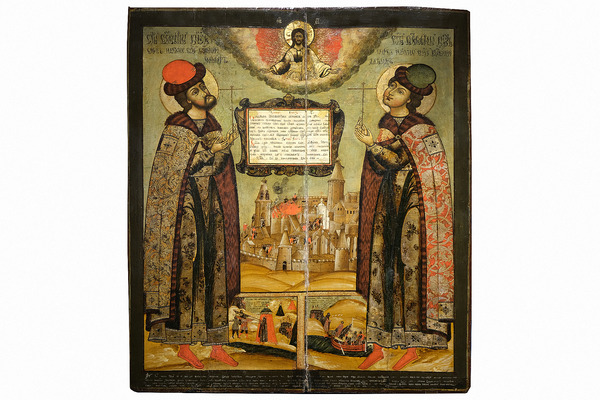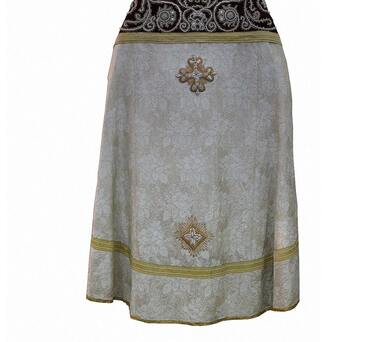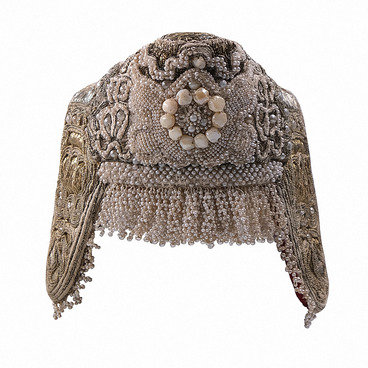Boris and Gleb were the first Russian saints. They died a martyr’s death, so it is customary to depict them on icons with crosses — symbols of martyrdom. The abbreviation “MM.” in the name of the icon also means the abbreviated “martyrs”.
At the top of the composition, the artist placed a cartouche (figured frame) with the text of the prayer. In the lower margin, there is a text about the plot of the work, describing the terrible fire in Kargopol on May 1, 1700. On that day, the prikaz house suddenly caught fire — the building where the voivodeship office, the local authorities, was located.
The fire was fierce: burning logs flew out of the city wall and set fire to the village yards. The courtyards were saved, but everything was burning inside the fortress itself: residents tried to put out the fire, but with no luck. Suddenly, Ss Boris and Gleb appeared in the flames walking along the edge of the roof of the Trinity Tower. Within the hour, the flame was extinguished.
The inscription on the icon testifies to many people seeing the miraculous phenomenon. Among them were the landrat (the head of the city subordinate to the governor) Ivan Lyapunov and a resident of the town Ivan Andreyev. Andreyev is not a surname, but a form of patronymic in the old days, this form was formed from the words “Ivan the son of Andrey”. His surname is not indicated on the icon, but the townspeople of that time did not need it: he came from a well-known Kargopol family and became famous for donations to churches and monasteries. After studying the surviving documents, researchers were able to establish his full name: Ivan Andreyev Popov.
The icon of Boris and Gleb was painted in the early 18th century in honor of the miraculous escape from the fire. It is considered especially valuable not only because of its artistic qualities but also because it has preserved the only image of the Kargopol fortress in its last years. The composition depicts the military-administrative center of the huge Kargopol Uyezd as it was at the beginning of the 18th century.
The artist did not reflect the exact type of fortification, only its most important parts. He painted four out of the nine towers. The artist rearranged the Trinity Tower, near which the fire started, and the Resurrection Tower in the background. Moreover, the Trinity tower faces the viewers with its front side.
The perimeter of the fortress was almost square. On each of its four sides, there was one tower with gates embedded in the ramparts. All the towers were made of solid logs. During construction, the tent-shaped roofs were overlapped with battens — boards that were obtained by the longitudinal splitting of a log using wedges. The towers were completed with observation platforms.
The prikaz house, where the fire started, consisted of three log cabins: large houses were built in old times by connecting logs (klet’). Nearby was the one-domed Hodegetria Church. Behind it, another temple with a dome is visible, presumably, this is the Mandylion of Edessa Church. In front of it, most likely, is the Church of All Saints.
At the top of the composition, the artist placed a cartouche (figured frame) with the text of the prayer. In the lower margin, there is a text about the plot of the work, describing the terrible fire in Kargopol on May 1, 1700. On that day, the prikaz house suddenly caught fire — the building where the voivodeship office, the local authorities, was located.
The fire was fierce: burning logs flew out of the city wall and set fire to the village yards. The courtyards were saved, but everything was burning inside the fortress itself: residents tried to put out the fire, but with no luck. Suddenly, Ss Boris and Gleb appeared in the flames walking along the edge of the roof of the Trinity Tower. Within the hour, the flame was extinguished.
The inscription on the icon testifies to many people seeing the miraculous phenomenon. Among them were the landrat (the head of the city subordinate to the governor) Ivan Lyapunov and a resident of the town Ivan Andreyev. Andreyev is not a surname, but a form of patronymic in the old days, this form was formed from the words “Ivan the son of Andrey”. His surname is not indicated on the icon, but the townspeople of that time did not need it: he came from a well-known Kargopol family and became famous for donations to churches and monasteries. After studying the surviving documents, researchers were able to establish his full name: Ivan Andreyev Popov.
The icon of Boris and Gleb was painted in the early 18th century in honor of the miraculous escape from the fire. It is considered especially valuable not only because of its artistic qualities but also because it has preserved the only image of the Kargopol fortress in its last years. The composition depicts the military-administrative center of the huge Kargopol Uyezd as it was at the beginning of the 18th century.
The artist did not reflect the exact type of fortification, only its most important parts. He painted four out of the nine towers. The artist rearranged the Trinity Tower, near which the fire started, and the Resurrection Tower in the background. Moreover, the Trinity tower faces the viewers with its front side.
The perimeter of the fortress was almost square. On each of its four sides, there was one tower with gates embedded in the ramparts. All the towers were made of solid logs. During construction, the tent-shaped roofs were overlapped with battens — boards that were obtained by the longitudinal splitting of a log using wedges. The towers were completed with observation platforms.
The prikaz house, where the fire started, consisted of three log cabins: large houses were built in old times by connecting logs (klet’). Nearby was the one-domed Hodegetria Church. Behind it, another temple with a dome is visible, presumably, this is the Mandylion of Edessa Church. In front of it, most likely, is the Church of All Saints.



